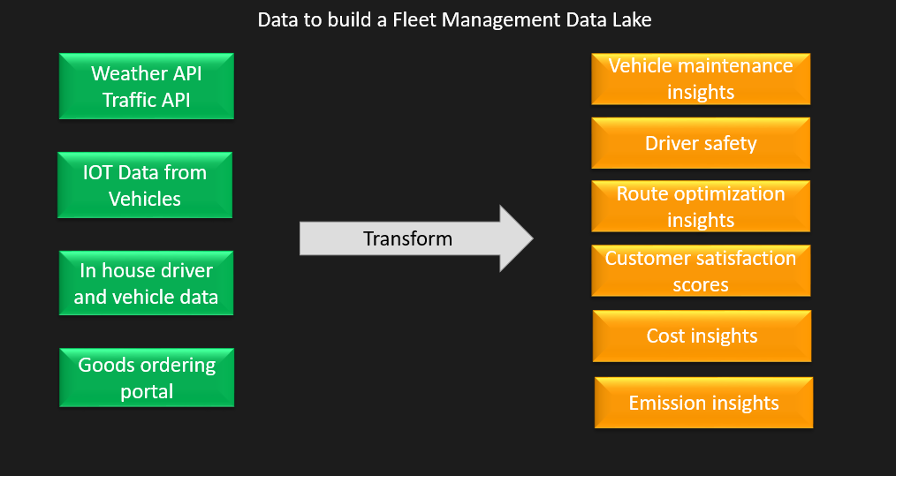AWS for Industries
Why CPGs and Logistics Vendors Need a Fleet Management Data Lake
Transportation is a critical piece of the puzzle for consumer packaged goods (CPG) manufacturers. It’s important to deliver materials and component parts to manufacturing facilities and to transport finished goods to retailers and consumers. This means CPGs are impacted twice when transportation and logistics become a challenge. According to inboundlogistics.com, transportation is expected to be tight through 2021, due to a labor shortage, an uptick in consumer buying, shipping challenges around the globe, unpredictable weather events, and the overall impact of the Covid-19 pandemic.
What’s the takeaway as you consider these factors? CPGs need to keep a close eye on their transportation needs. Or better yet, manufacturers should proactively manage inbound and outbound transportation needs to react quickly when issues arise.
You might be wondering what you can do to proactively manage your transportation needs. The answer: Create a fleet management data lake. In this blog post, we’ll show you how a data lake can help CPGs and logistics vendors manage transportation and a fleet of delivery vehicles.
CPG Fleet Management at a Glance
Fleet management is the practice of tracking all of the data associated with your transportation needs and your fleet of vehicles. For example, many CPGs track delivery costs, cost per unit of goods, import and export fees and taxes, timing of deliveries, fuel usage and costs, accidents, driver and route details, and other information that might impact deliveries, like fuel shortages or weather events.
If your company has its own fleet of vehicles, you might also need to track vehicle maintenance, driver credentialing and satisfaction scores, on-time deliveries, driving speeds, fuel efficiency, and safety issues. No matter if you’re a CPG or a logistics vendor, this information can help you understand your transportation patterns and needs so you can optimize fleet management to gain operational efficiencies, lower costs, improve vehicle utilization, and increase the overall throughput of goods.
The Data Challenge of Fleet Management
The data points and shipping details we just mentioned, while insightful and necessary, create their own challenges: namely, managing and making sense of all the information. To compound the issue, data comes in structured and unstructured formats and flows from many different channels, such as real-time vehicle sensors for things like temperature and speed; external sources such as vehicle maintenance information, fuel logs, and DOT records; and in-house data stores from HR, SCM, and CRM systems. CPGs and logistics vendors need to extract, collect, combine, and gain insights from this information. The faster you can manage this data ecosystem, the more proactively you can optimize your transportation needs and react when disruptions occur.
Data Lake to Manage CPG Transportation and Fleet Information
Data lakes, also known as data repositories, can be used to store any magnitude of information, regardless of the type or format of data. They have become an effective solution for managing transportation and fleet information. With all your data in a single repository, you can run analytics on it, gain insights, and make better decisions, with guidance from machine learning (ML), big data processing, real-time analysis, and visualization dashboards.

When you collect and analyze different data sources like those on the left, you can gain insight and make informed decisions to optimize and proactively manage your transportation and fleet needs, as shown on the right.
CPG Transportation and Fleet Management Use Cases
Here are some common use cases for using an AWS data lake for transportation and fleet management:
- Vehicle maintenance—You can manage vehicle-related data, like oil temperature, tire pressure, and vehicle part vibrations, from real-time sensors. Your drivers and maintenance crews can detect anomalies to proactively address mechanical issues. Raw data collected from vehicle sensors can be stored and analyzed in an AWS data lake to help reduce unscheduled maintenance and cost-effectively manage spare parts.
- Driver safety—With audio and video streams from in-cabin sensors, combined with vehicle speed, acceleration, and braking data, you can determine whether drivers are following the rules of the road. When data is staged in an AWS data lake and enriched with weather, geolocation, and traffic data, you can detect potentially dangerous situations and send real-time, in-cabin Alexa warnings to drivers alerting them to traffic delays, unsafe conditions, or reckless behaviors. You can also use this data to score drivers on safety compliance and create incentive programs to reward safe drivers.
- Route optimization—By correlating vehicle information with traffic, weather, delivery location, and supply chain data, you can train ML algorithms to optimize delivery routes. As weather and traffic conditions change, you can get real-time revised delivery routes.
- Customer satisfaction—You can aggregate customer demographic and behavioral information with data on successful and unsuccessful delivery attempts, stock keeping units, and package-level features to create optimal delivery schedules.
- Cost and emissions reduction—By increasing throughput of deliveries per vehicle per day, you can reduce transportation costs and vehicle emissions. This involves optimizing routes, maximizing cargo density in each vehicle, and fine-tuning cargo staging so vehicle loading is seamless. By tracking order-fulfillment information, delivery routes, vehicle dimensions, and the weight and volume of cargo, you can improve delivery throughput while reducing the number of delivery vehicles.
In a follow-up blog post, we’ll share steps and AWS services you can use to create a robust, scalable fleet management data lake.
If you’re ready to move forward with a fleet management data lake, contact your AWS account team today to get started.